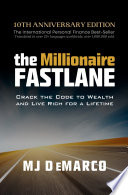

In 'The Millionaire Fastlane', MJ DeMarco introduces three paths to wealth: the Sidewalk, the Slowlane, and the Fastlane. The Sidewalk represents a life of financial irresponsibility, where individuals live paycheck to paycheck, often accumulating debt and lacking a plan for wealth. The Slowlane is a more conventional approach, where people work a steady job, save a little, and invest in traditional assets like retirement accounts, expecting to become wealthy in the distant future. The Fastlane, however, is the path DeMarco advocates for; it emphasizes entrepreneurship, leveraging business systems, and creating scalable wealth. The Fastlane encourages individuals to take control of their financial destiny by building businesses that can generate significant income without the limitations of a traditional 9-5 job. This concept is pivotal because it challenges the conventional wisdom of wealth accumulation, urging readers to rethink their approach to financial freedom.
Continue readingDeMarco asserts that true wealth is not merely a result of hard work or high income but is created through value generation. He emphasizes that wealth creation comes from identifying problems and providing solutions that people are willing to pay for. This principle shifts the focus from working for money to creating systems and products that generate income passively. For example, entrepreneurs who develop software, write books, or create online courses can earn money while they sleep. This idea is crucial because it empowers individuals to think creatively and innovatively, recognizing that their skills and ideas can lead to wealth if they are channeled into solving real-world problems.
Continue readingA central theme in DeMarco's philosophy is the importance of control over one's financial destiny. He argues that many traditional paths to wealth, such as saving and investing in mutual funds, place individuals at the mercy of external factors like market fluctuations and economic downturns. In contrast, the Fastlane emphasizes creating businesses that provide the entrepreneur with direct control over their income and growth potential. By owning a business, individuals can make strategic decisions that directly impact their financial success. This idea encourages readers to seek opportunities where they can take charge of their financial future rather than relying on others or external circumstances.
Continue readingDeMarco introduces the Law of Effection, which posits that the degree of wealth you can achieve is directly proportional to the number of lives you affect. This principle encourages entrepreneurs to think beyond mere profit and consider the impact of their products or services on society. By focusing on creating value that positively affects a larger audience, individuals can build businesses that not only generate wealth but also contribute to the community. This idea is vital because it aligns financial success with social responsibility, urging entrepreneurs to think about the broader implications of their work.
Continue readingIn the Fastlane, speed is a critical factor in achieving wealth. DeMarco argues that the faster you can bring a product or service to market, the quicker you can start generating income. This contrasts with the Slowlane approach, where individuals often delay their financial goals through prolonged education or saving. The Fastlane mindset encourages taking calculated risks and acting swiftly to capitalize on opportunities. This idea is essential for aspiring entrepreneurs, as it highlights the importance of agility and responsiveness in the fast-paced business world.
Continue readingDeMarco emphasizes that a successful entrepreneur must cultivate a mindset geared toward abundance, resilience, and continuous learning. He argues that many people are held back by limiting beliefs about money and success, which can hinder their ability to take risks and seize opportunities. By adopting a growth mindset, individuals can overcome obstacles and embrace challenges as opportunities for growth. This idea is crucial because it underscores the psychological aspects of entrepreneurship, encouraging readers to develop a mindset that supports their goals.
Continue readingFinally, DeMarco stresses the need for financial literacy as a cornerstone of the Fastlane approach. Understanding how money works, including concepts like cash flow, investment strategies, and market dynamics, empowers individuals to make informed decisions about their financial futures. Financial literacy also enables entrepreneurs to navigate the complexities of running a business, from pricing strategies to understanding profit margins. This idea is vital because it equips readers with the knowledge necessary to succeed in their entrepreneurial endeavors and manage their wealth effectively.
Continue reading